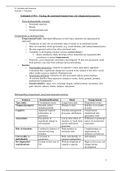#1 Attitudes and Emotions
Vignette 1: Emotions
Goldsmith (1994) – Parsing the emotional domain from a developmental perspective
- Three distinguishable concepts:
o Emotional reactions
o Moods
o Temperamental traits
Temperament as emotional traits
- Temperamental traits: individual differences in how basic emotions are experienced &
expressed
o Tendencies to enter into an emotional state or remain in an emotional moods
o Does not constitute whole personality (e.g. social attitudes, self-related characteristics
o Become organized earlier than other emotional traits
o Variability in developing emotion systems (systems theory)
Some consistency likely develops in how transitions are negotiated (this
consistency is termed temperament)
o Properties: cross-situational consistency and temporal does not necessarily result
from genetics, can arise from schemas and social learning
- Emotion
o Functionalist perspective: emotion as organism’s sense (perception, appraisal,
evaluation) that a significant change has occurred in the relation of the self to social
others (either actual or implied) interpersonal
o Structuralist definition: emotions are also associated with an action tendency
emotion families share expressive features (vocalic, facial, gestural, postural,
instrumental components)
o Emotion families: anger, awe, contempt, disgust, embarrassment, excitement, fear,
guilt, interest, sadness, shame, surprise, enjoyment
Distinguishing temperament, mood and emotional reactions
Features Emotional Reaction Mood Temperament
Type entity Coordinated events Longer-term state Disposition or trait
Temporal property Seconds, unless Minutes to days Stability over months
stimulus persists & years
Cognitive Appraisal required Emotion-management Temperament
(elementary or processes, attributions transformed into
automatic) personality traits
Antecedents Perceptions of Can be after-effect of Difference in genotype
significant change in emotion, or result from and/or environmental
environment poorly understood experience
processes
Role of situations Confined to features of Help maintain or Complementary to
emotion-eliciting terminate state temperament, as
stimulus influence on behavior
Universality vs. Universal in Both, individuality in Individuality
individuality occurrence emotion management
Developmental Evident in first year of With development of Begin in first year, can
considerations life cognitive capacity change during
development
1
, #1 Attitudes and Emotions
Vignette 1: Emotions
Davidson (1994) - On Emotion, Mood, & Related Affective Constructs
- Criticizes how the aspects of affect (mood & emotion) are distinguished (by duration & facial
expressions) he proposes:
Mood Emotion
- Primary function: modulate or bias - Primary function:
cognition altering info-processing modulate or bias action
priorities (accentuate access of cognitive most often arises when
contents; e.g. depressed increased access adaptive action required
to sad memories) & shifting modes of info- Phasic perturbations
processing (e.g. positive mood facilitates superimposed on
cognitive flexibility) background
Provides affective background - Antecedents: occurring
- Antecedents: occurring over slower time quickly & without warning
course (e.g. weather, cumulative mild events) (e.g. accident)
- Moods & emotions can dynamically interact
- Affective Style = entire domain of individual differences that modulate a person’s reactivity to
emotional events (trait-like mood not included but temperament)
Temperament: early consistent differences can lead to systematic biases in
emotional reactivity in children
Ekman (1994) - Moods, Emotions, & Traits
Mood Emotion
- Duration: last longer (hours to days) - Duration: short-lived (sec to min)
- Lowers threshold for arousing - Distinctive facial expressions
- Antecedents often unknown/unclear - Antecedents clearer
2 possibilities:
1. Neurohormonal, biochemical
2. Dense emotional experiences
Frijda (1994) - Varieties of Affect: Emotions & Episodes, Moods, & Sentiments
Dimensions:
- Relation between subject & particular object/event :
o Intentional: relationship of psychological state & object emotions (emotional
experience + behavior = object-focused states of mind & of behavioral readiness)
o Unintentional: no relationship of psychological sates & object moods
- Process/state (acute or less enduring):
o Affect: pleasant or unpleasant feeling
o Appraisal: perception & evaluation of emotional event
o Action readiness: action tendencies to establish or disrupt relationships to
environment & states of activation
Compose affective states & moods (but moods don’t have a focus)
- Duration:
o Emotion episode: intermittently experiences of the same emotion over extended
periods (with overall intensity & emotional state fluctuating)
Sentiments: dispositions to respond affectively to objects/events base for emotions
- Antecedents: previous experience or innate basis
- Reciprocal relationship with emotions
- Structure:
1. Cognitive dispositions & schemas to appraise an object in a particular way
2. Latent motivations that become acute on actual or possible confrontation with object
- Personality Dispositions: propensities to appraise events in terms corresponding to emotions
2





